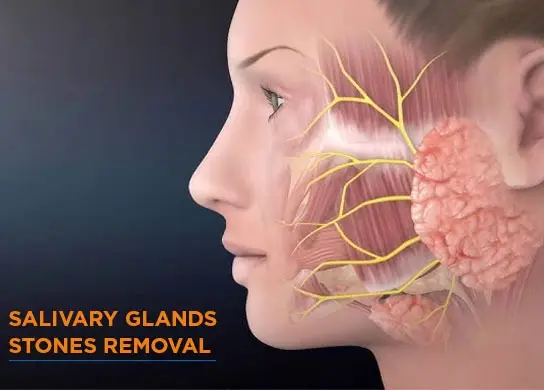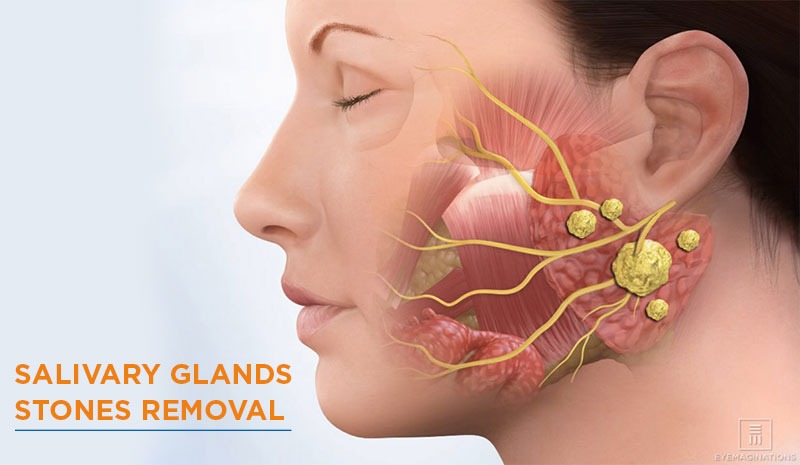
If you’ve ever felt sudden pain under your jaw while eating or noticed swelling that comes and goes, you might be dealing with salivary gland stones, also known as sialolithiasis. These tiny calcium-based stones can block saliva flow, causing discomfort and infection. But don’t worry — with the right care, treatment is simple and effective. In this blog, we’ll walk you through salivary gland stone removal in Ahmedabad, including causes, symptoms, treatment options, and how a qualified ENT specialist can help you get back to pain-free living.
What Are Salivary Gland Stones?
Salivary gland stones, also known as sialolithiasis, are tiny, hardened deposits that can develop within the ducts of your salivary glands. While they may seem unusual, they’re a pretty common source of facial pain and swelling, particularly in adults aged 30 to 60.
Where Do These Stones Form?
You have three major pairs of salivary glands:
- Submandibular glands (under your jaw)
- Parotid glands (in your cheeks, near your ears)
- Sublingual glands (under your tongue)
Most stones (over 80%) develop in the submandibular glands, where saliva is thicker and flows upward, making it more prone to blockages.
Why Do These Stones Form?
Salivary stones are usually composed of calcium, form when saliva gets stuck or doesn’t flow properly through the ducts. Over time, minerals accumulate and solidify into a stone. Some common contributing factors include:
- Dehydration
- Poor oral hygiene
- Reduced saliva production (from medications or medical conditions)
- A diet low in citrus or acidic foods
- Infrequent meals or irregular eating patterns
While those tiny stones might slip under the radar, the bigger ones can completely block the duct, leading to a buildup of saliva and, eventually, swelling, infection, and quite a bit of discomfort. The silver lining? Many of these stones can actually be removed without the need for surgery, especially if caught early on. In cities like Ahmedabad, patients now have access to ENT specialists who are skilled in advanced techniques like sialendoscopy, making treatment safer and more effective than ever before.
![Salivary Glands Stones Removal]() Symptoms to Watch For
Symptoms to Watch For
Salivary gland stones often don’t show symptoms right away, which is why many people might overlook the signs for weeks or even months. However, once the duct gets blocked or inflamed, symptoms can pop up out of nowhere and escalate pretty quickly.
Most Common Symptoms Include:
- Pain or swelling in the jaw, neck, or floor of the mouth, especially during or right after eating (when saliva production increases)
- A dry mouth or difficulty swallowing
- A bad taste in the mouth — often metallic or foul
- Redness or tenderness under the tongue or jaw
- Pus drainage or fever (in cases of infection)
Diagnosis: How ENT Specialists in Ahmedabad Identify the Problem
Figuring out if you have a salivary gland stone is usually pretty simple, especially if you’re seeing a seasoned ENT specialist. In Ahmedabad, you’ll find plenty of ENT clinics that have the know-how and the latest diagnostic equipment to pinpoint the presence, size, and exact location of the stone, often during your very first visit.
Step-by-Step Diagnosis Process
1. Physical Examination
When you visit an ENT, they’ll start by gently feeling around under your jaw or inside your mouth. Often, they can manually detect a stone in the submandibular duct, or you might even spot a small white lump under your tongue. They’ll also look for any tenderness, swelling, or signs of infection, like pus.
2. Medical History
The specialist will ask about:
- Frequency and timing of pain (e.g., during meals)
- Any history of dehydration or chronic mouth dryness
- Medications that might reduce saliva flow
3. Imaging Tests
If the stone is deeper inside the gland or not visible through a simple exam, your ENT may recommend one or more of the following:
- X-rays: Useful for detecting larger or calcified stones
- Ultrasound: A non-invasive way to visualize the stone’s location and rule out abscesses
- CT Scan: High-detail imaging used for complex or multiple stones
- Sialography: A contrast dye is injected into the duct before an X-ray is taken — helpful for duct mapping (less commonly used today due to sialendoscopy)
Why See an ENT Specialist for This?
While many patients might first visit their dentist, it’s actually the ENT doctors who possess the specialized tools and surgical know-how to handle a wide array of treatments, from making a diagnosis to performing minimally invasive procedures. In Ahmedabad, there are numerous ENT clinics equipped with in-office endoscopy tools, which means that both diagnosis and treatment planning can often be wrapped up in just one visit.
Treatment Options for Salivary Stones
The great news is that most salivary gland stones can be treated effectively, often without the need for major surgery. The treatment you’ll receive will depend on factors like the size, location, and severity of your stone, as well as whether there’s an infection involved. In Ahmedabad, ENT specialists provide a comprehensive range of options, from simple at-home care to minimally invasive procedures that can be done right in the clinic.
-
Conservative Treatments (for small or early-stage stones)
If the stone is tiny and near the surface of the duct, your doctor might recommend trying to pass it naturally with:
- Increased hydration: Drinking more water stimulates saliva flow
- Sialogogues: Sour candies (like lemon drops) that trigger saliva production
- Warm compresses & massage: Applying heat and gently massaging the area
- Good oral hygiene: To prevent bacterial buildup around the gland
Success Rate: High for stones under 2mm
Limitation: May not work if the stone is stuck deeper in the duct
-
Manual Expression or Duct Probing
If you have stones that are situated near the opening of the duct—often visible right under your tongue—your ENT specialist might carefully extract the stone by applying some pressure or using a probe, all while you’re under local anesthesia.
Quick and simple
Time required: Usually less than 15 minutes
Often done right in the ENT’s office
-
Sialendoscopy: Minimally Invasive Removal
Sialendoscopy is an innovative, scar-free procedure that involves inserting a tiny camera, known as an endoscope, into the salivary duct. Once the stone is found, specialized tools are used to either remove it or break it down into smaller pieces.
Why do patients in Ahmedabad prefer sialendoscopy?
- No stitches or external incisions
- Performed under local or light general anesthesia
- Short recovery time (usually 1–2 days)
- Low risk of complications
Availability in Ahmedabad:
Advanced ENT clinics and multispeciality hospitals like Aashwi ENT Hospital now offer this procedure with skilled ENT surgeons.
Surgical Removal (Rare, but Necessary Sometimes)
If the stone is:
- Too large
- Deep inside the gland
- Causing repeated infections
Your ENT might recommend gland excision (removing part or all of the salivary gland). This is done under general anesthesia in a hospital setting.
This is usually considered a last resort, and only recommended if:
- Stones keep coming back
- There’s a chronic infection
- The gland is no longer functioning properly
Recovery: 7–10 days
Follow-up: Regular post-op checkups to monitor healing and saliva production
What About Pain and Recovery?
- Most non-surgical methods (like sialendoscopy) have minimal pain, usually managed with over-the-counter medication.
- Eating soft, non-acidic foods for a few days post-treatment helps with healing.
- Most patients return to work or school within 1–2 days (for non-surgical options) or 7–10 days (for surgery).
Patient Experience: What to Expect Before, During & After Removal
If you’re considering getting salivary gland stones removed in Ahmedabad, it’s normal to feel a bit anxious about what the whole process entails. But here’s the silver lining: modern treatments, particularly sialendoscopy, are not only safe but also fairly quick and typically done on an outpatient basis. So, what can you expect during a typical visit to a qualified ENT specialist?
Before the Procedure
Once your ENT confirms the presence of a salivary gland stone (via physical exam and imaging), they’ll explain the best treatment option based on:
- The stone’s size and location
- Your symptoms
- Whether infection is present
You may be advised to:
- Stay well-hydrated
- Avoid hard or acidic foods temporarily
- Start antibiotics if an infection is found
If the stone is large or deeper in the duct, your ENT may schedule you for sialendoscopy or minor surgery.
During the Procedure
For simple stone removal:
- Local anesthesia may be applied
- The ENT uses a small instrument to massage or extract the stone manually
- Time required: Often 10–30 minutes
For sialendoscopy:
- A tiny endoscope is inserted into the duct
- The stone is removed using micro-instruments
- Usually painless, with just a slight pressure or stretching sensation
- Often performed in a clinic or hospital day-care unit
After the Procedure
- Mild swelling or soreness for 1–2 days is common
- ENT may prescribe:
- Antibiotics (if infection was present)
- Pain relievers
- Mouth rinses
- Most patients return to normal eating within 24–48 hours
- A follow-up appointment is typically scheduled after 1 week
Patients often walk out feeling relieved — and surprised at how simple the process was.


 Symptoms to Watch For
Symptoms to Watch For